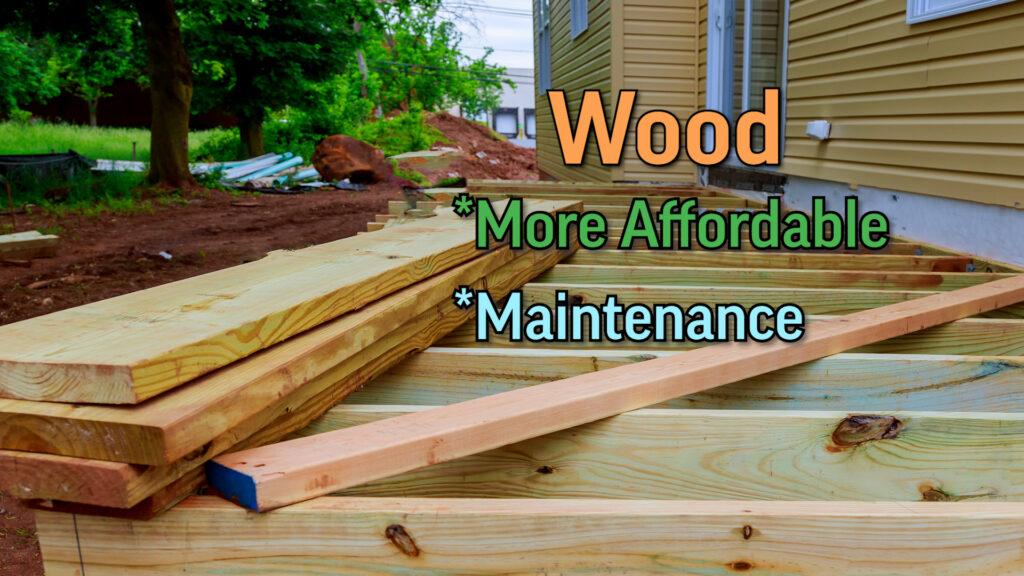
In this article, we’ll be delving into the question: How much does a new deck cost? You’re planning and eager to establish a budget range. Today, we’ll walk you through the process and discuss several factors that can significantly influence the cost of your deck project.
The initial decision in any deck project is choosing between wood or composite materials. It’s like the first fork in the road when making decisions for your deck.
Wood has a traditional look, typically crafted from treated lumber. Opting for a wood deck is a more cost-effective choice compared to a composite deck. However, it’s essential to consider the maintenance aspect. A wood deck demands staining every couple of years. When you factor in the cost of staining and treating the deck over time, the long-term maintenance expenses can surpass the upfront cost of opting for a composite deck.

A composite deck opens up a wide array of possibilities, from various materials and railings to deck boards and designs. Prices can vary significantly based on the materials you choose, offering flexibility in creating the deck that suits your preferences and budget. When it comes to a composite deck, the options are vast – from materials and railings to deck boards and designs. Prices can vary significantly based on your material choices. Take aluminum railing as an example – it’s just one of the many options available. We often receive inquiries about cable railing and even glass panels, each with its unique cost range.
For instance, a basic aluminum rail typically costs just under $200 per section in terms of material. Basic composite rails usually fall around $140 to $150 per section. However, cable railing can go as high as $500 or $600 per section, while glass panels are even more expensive. To give you a rough estimate, composite is the most basic, followed by aluminum, and then the more intricate options like stainless steel cable or wire mesh can be considerably pricier.

When it comes to deck boards, manufacturers typically offer a good, better, and best option. At Property Revolution, we are TREX certified, having undergone certification courses that allow us to extend some of TREX’s warranties on each project. Our preference is often TREX’s deck boards, which have consistently performed well for us.
In terms of cost, let’s use TREX as an example to provide you with a rough estimate of the scope. A basic composite deck board might be around $30 to $32 per board, not significantly more than lumber. The mid-range boards can range from $50 to $60 each, while some of the higher-end options can go as high as $100 per deck board. This breakdown should give you an idea of how the choice of materials can influence the overall cost of your deck.

If you’re in the process of budgeting for your deck project, it’s advisable to anticipate spending between $30 to possibly $100 per square foot, depending on the materials you choose. A basic wood deck might currently cost around $30 per square foot, while a composite deck could start at approximately $60 per square foot and increase based on your material preferences.
Opting for higher-end materials could further increase the cost of your deck project. Additionally, the shape and design of the deck play a significant role in influencing costs. Rectangles and squares in two-foot increments are the most economical and cost-effective. For those seeking the best value, building in increments of 12, 16, and 20 is recommended since these are the standard lengths of materials, minimizing waste.
It’s worth noting that the cost to build an 11 by 15 deck would be the same as a 12 by 16 because the materials remain exactly the same. Therefore, squares and rectangles prove to be more budget-friendly, and simpler designs are also generally more cost-effective.

Indeed, if you’re interested in intricate patterns like a herringbone pattern, picture framing, or any fancier designs, be prepared for an additional impact on the overall cost of your deck project. These details contribute to a more complex construction, thereby influencing the expenses associated with the project.

The height of the deck is another factor influencing its cost. Ground-level decks tend to fall within the lower end of the price range I mentioned, around $30 or $60 per square foot. As the decks get taller, the construction becomes more intricate, requiring thicker posts, which can lead to a slight increase in prices for taller decks. Additionally, taller projects often involve a greater number of stairs, further contributing to the overall cost.
Another factor that can significantly influence the cost and is gaining popularity is lighting. This year, we’ve especially delved into built-in lighting kits for decks, offering various options such as post cap lights, post side lights, and deck board lights, commonly known as puck lights. Lighting not only enhances the aesthetics of your deck, giving it a cool look but also is a relatively manageable add-on in terms of cost.

These are the crucial aspects to consider as you map out your deck project. From material selection to design choices, height considerations, and even the addition of lighting, each decision plays a role in shaping both the aesthetics and the cost of your envisioned deck. We would sit down with you for a few minutes to understand your ideas. Our approach involves providing quotes for at least three different options, allowing you to visualize different scenarios to make an informed decision. From there, we can tailor a proposal that aligns with your preferences and requirements.

If you’re interested in envisioning how we can bring your deck to life, don’t hesitate to reach out. We’re always happy to help!

